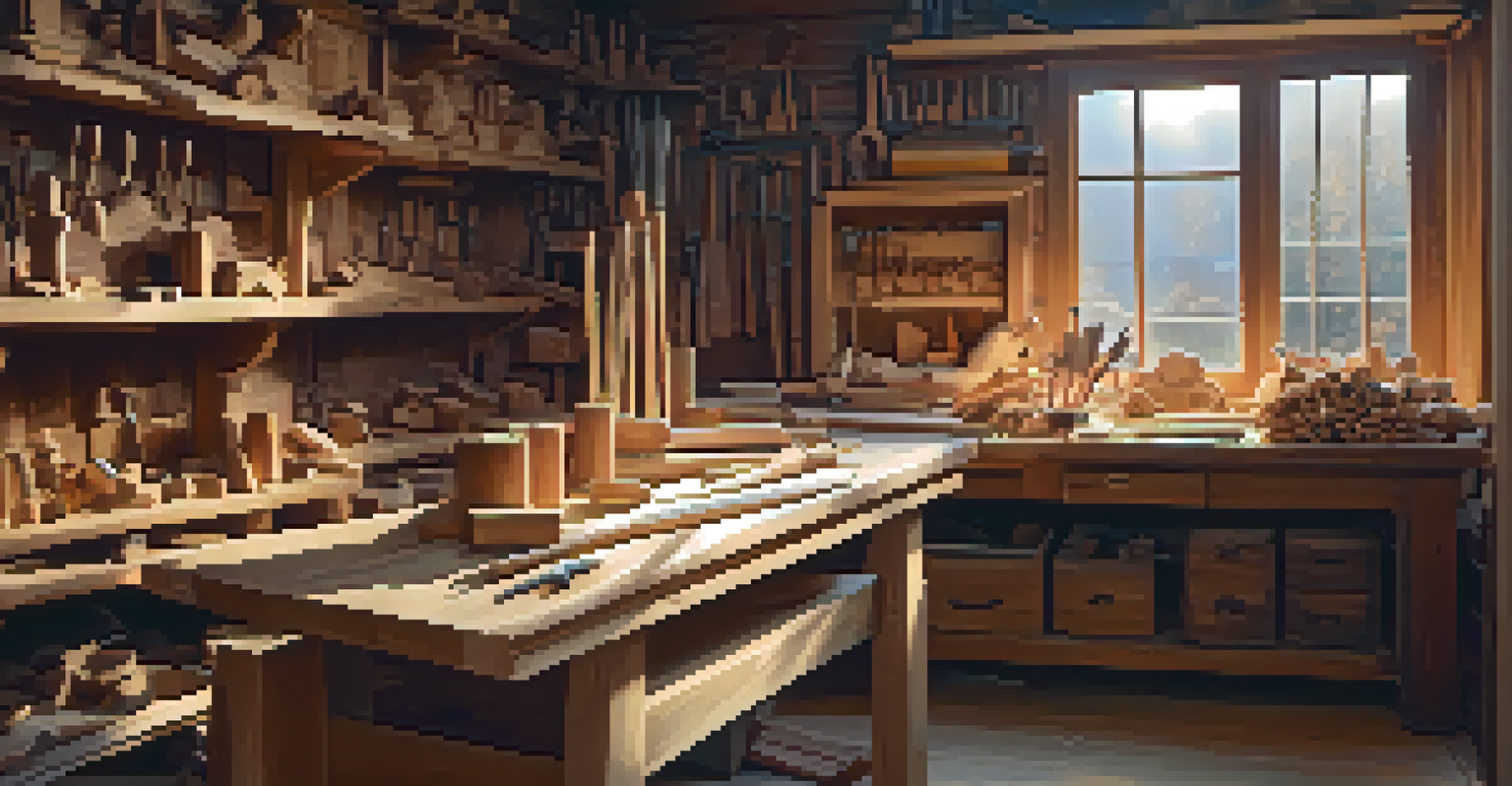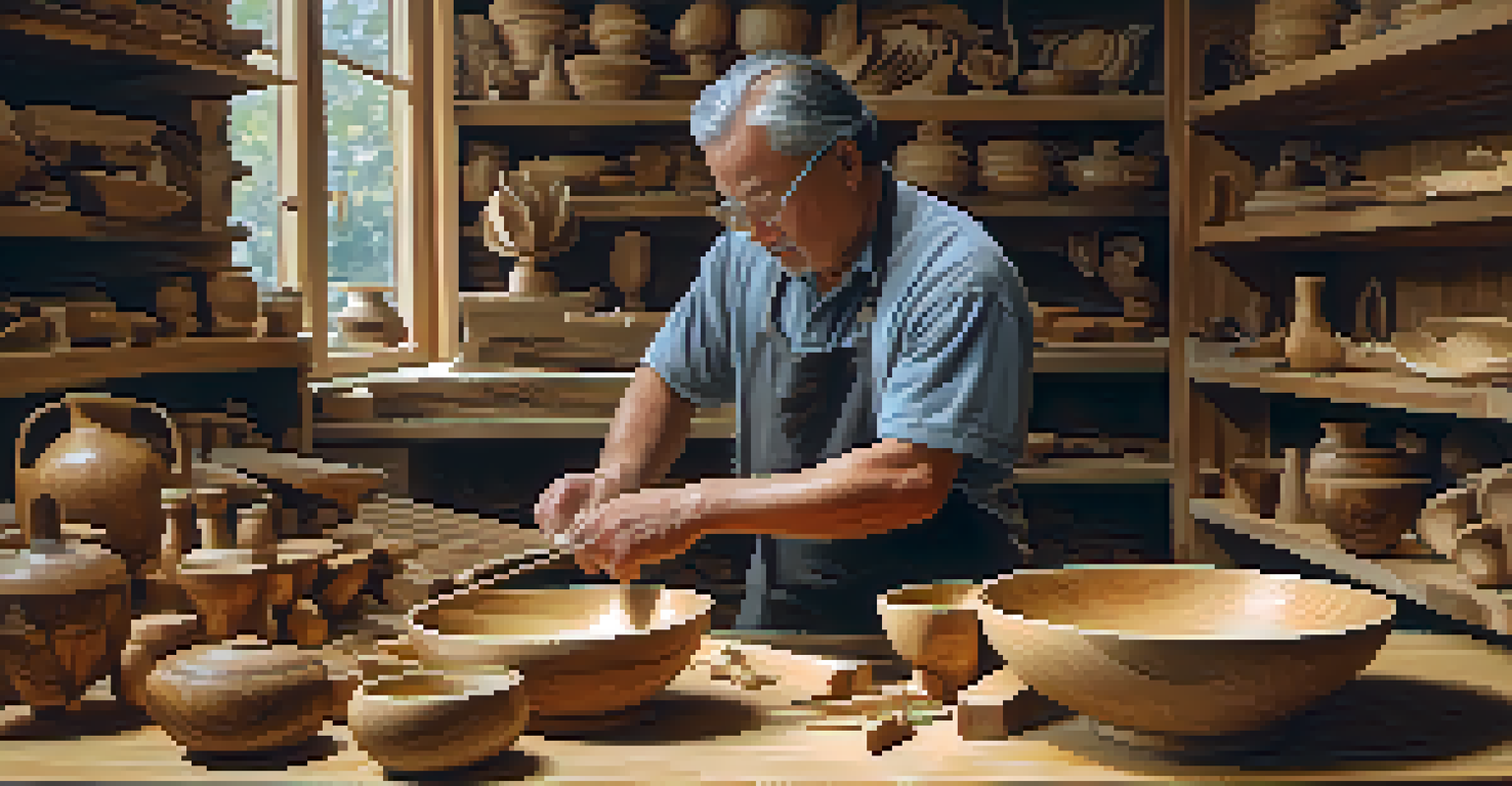Comparing the Materials: Stone vs. Wood in Carving

Understanding Stone Carving: Durability and Detail
Stone carving offers a unique durability that wood simply can't match. When you carve into stone, you're creating something that can last for centuries, standing the test of time against weathering and decay. This longevity is what draws many artists to use materials like marble or granite, as their creations can endure for generations.
The marble not yet carved can hold the form of every thought the greatest artist has.
However, stone also poses its challenges. Unlike wood, which can be easily manipulated, stone requires specialized tools and techniques. This can make carving stone a more labor-intensive process, demanding patience and skill to achieve the desired detail and finish.
To illustrate this, consider the intricate sculptures of Michelangelo. His famous works, carved from solid blocks of marble, showcase how stone can be transformed into breathtaking art. Yet, the effort involved in achieving such detail reminds us that while stone is durable, it's not always easy to work with.
Diving into Wood Carving: Versatility and Warmth
Wood carving stands out for its versatility and warmth, making it a popular choice among artisans. Unlike stone, wood can be carved with relative ease, allowing for a wide variety of shapes and designs. This accessibility means that both beginners and seasoned carvers can explore their creativity without the intimidation that stone can often bring.

Moreover, wood has a unique aesthetic quality. Each type of wood carries its own grain patterns and colors, adding character to the finished piece. For example, cherry wood darkens beautifully over time, giving carved items a rich, warm look that many people find appealing.
Stone Carving Offers Durability
Stone carving provides exceptional longevity, making it an ideal choice for artists aiming to create lasting works of art.
Think of a cozy wooden sculpture in your home, perhaps a beautifully carved figure or an intricate bowl. These pieces not only serve as functional items but also as works of art that bring a natural warmth to any space, showcasing the charm and beauty that wood can offer.
Comparing Carving Techniques for Stone and Wood
When it comes to carving techniques, stone and wood require different approaches. Stone carving often involves chiseling and grinding, where artists must apply significant force to shape the material. This technique can be quite physically demanding and requires a solid understanding of the stone's properties to avoid cracking or breaking.
Wood is the most humanistic of all materials. It has a warmth and beauty that can never be replaced.
In contrast, wood carving can employ a range of techniques, such as whittling, chiseling, and relief carving. These methods allow for more flexibility and experimentation, enabling artists to create everything from detailed figurines to large sculptures. The tools for wood carving are generally more accessible, often including simple knives and gouges.
Consider a wood carver at work, skillfully removing thin shavings to reveal a detailed design. This process often feels more immediate and interactive than stone carving, where each strike carries more weight and consequence. Both techniques, while different, offer unique rewards and challenges that cater to various artistic preferences.
The Aesthetic Qualities of Stone vs. Wood
Aesthetically, stone and wood convey distinctly different emotions and styles. Stone, with its cool, hard surface, often embodies strength and permanence. This is why many monumental sculptures and architectural elements are crafted from stone, as they communicate a sense of stability and grandeur.
Wood, on the other hand, exudes warmth and approachability. Its organic textures and colors can create a more inviting atmosphere, making it ideal for home decor and functional art pieces. The natural imperfections found in wood often add to its charm, making each piece feel unique and personal.
Wood Carving is Versatile
Wood carving is celebrated for its accessibility and warmth, allowing both beginners and experts to easily explore their creativity.
Picture a grand stone statue standing proudly in a park, versus a beautifully carved wooden bench inviting people to sit and relax. Each material tells its own story through its appearance, and understanding these aesthetic qualities can help artists choose the right medium for their vision.
Environmental Considerations: Sustainability in Carving
In recent years, sustainability has become an important factor for artists choosing their materials. When it comes to stone, the extraction process can be quite resource-intensive, often involving significant environmental disruption. This raises questions about the long-term impact of quarrying practices and how they affect local ecosystems.
Wood, if sourced responsibly, can offer a more sustainable option. Many wood carvers now prioritize using reclaimed or sustainably harvested wood, reducing the environmental footprint of their creations. By choosing materials that are certified as sustainable, artists can contribute to conservation efforts while still enjoying the beauty of wood.
Imagine the difference between a carving made from an ancient tree that was cut down without regard for the ecosystem versus one crafted from reclaimed barn wood. The latter not only tells a story of reuse but also honors the environment, showing how artists can make mindful choices in their material selection.
Cost Considerations: Stone vs. Wood Carving
Cost is another factor to consider when comparing stone and wood for carving projects. Generally, stone can be more expensive due to the cost of raw materials and the specialized tools required for carving. Additionally, some types of stone, like marble or onyx, can be quite costly and may not be accessible for all artists.
Wood, on the other hand, usually presents a more budget-friendly option. With a wide range of species available, from affordable pine to more expensive exotic woods, carvers can find materials that fit their budget and project needs. Plus, the tools for wood carving are often less expensive and more readily available.
Sustainability in Material Choices
Choosing between stone and wood involves considering sustainability, as responsibly sourced wood can offer a more environmentally friendly option.
Think of a beginner artist looking to start their carving journey. They might find it easier to invest in a set of wood carving tools and some softwood than to dive into the world of stone. This cost difference can significantly influence the choice of medium, especially for those just starting out.
Final Thoughts: Choosing the Right Medium for Your Art
Ultimately, the choice between stone and wood carving depends on personal preference, skill level, and the specific project at hand. Each medium offers unique advantages and challenges that can shape the artistic process. While stone may appeal to those seeking permanence and grandeur, wood may attract those looking for warmth and versatility.
As artists explore these materials, they should consider not just the technical aspects but also the emotional resonance of their chosen medium. The stories that stone and wood can tell through their textures and forms can deeply influence the impact of the finished work.

So whether you find yourself drawn to the solidity of stone or the inviting nature of wood, remember that both mediums hold endless possibilities. The key is to embrace the journey of carving, allowing your creativity to guide you towards the perfect expression of your artistic vision.